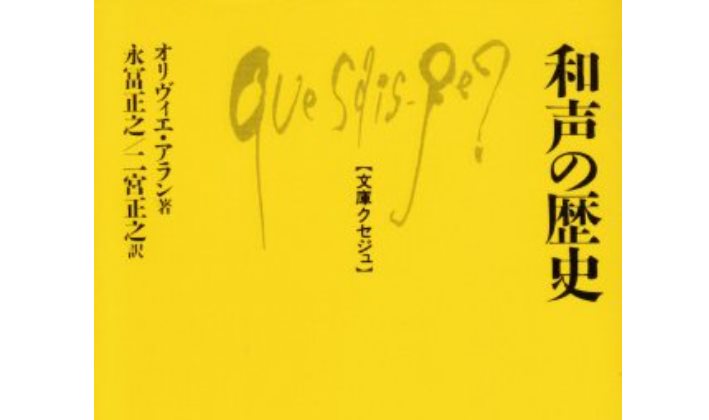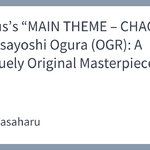(Original posted on April 10, 2002)
Harmony, or “chōwa” in Japanese, translates to “concord” or “agreement.” This book does not confine harmony to the framework of functional tonality but traces its history as something that represents and governs that very concord. To borrow the book’s own words, it is an attempt to see harmony as a long, continuous line running through the history of music.
This historical journey begins in the 10th century, or even around the 5th-6th centuries if we include the general outline. The earliest form of harmony observed is what could be called a “harmony of intervals,” where melodies move in parallel, constantly maintaining a relationship of fourths and fifths. The book begins tracing the history of harmony from this point.
The pages turn faster when you reach the section that depicts the transformation from the twilight of tonality to its saturation and transcendence. It does so by highlighting the individual differences among 18th- and 19th-century composers—which elements of tonal harmony they keenly pushed forward and, conversely, which they did not. The tempo of the writing, combined with the subject matter, makes this a compelling part of the book.
For example, in a section titled “Modality and Tonality,” the author points out that many Russian and French composers of the 19th century incorporated modality into conventional (traditional) tonality, allowing them to coexist. In other words, modality was used as an element to skillfully push back against the oppression brought by tonality.
This pursuit of modality was not seen in Germany during the same period, where a thorough chromaticism led them to a “state of sonic saturation” sooner, via polytonality. In France and elsewhere, however, the utilization of modes and polymodality meant that the emergence of music that felt similarly saturated came somewhat later.
Furthermore, in the following section “The Twilight of Tonality,” the author cites the “concealment, burial, and forgetting of tonality” through modal materials and orchestration techniques as a harmonic feature of Debussy’s works. He states that while its harmonic skeleton (limitedly) adhered to modal tonality, Debussy enriched the harmony by using polymodality and polytonality, borrowing IV, I, and V chords from various modes and avoiding the movement of the leading tone. This, he says, paved the way for Messiaen’s techniques.
Now, one thing that excellent history books have in common is a skillful sense of perspective when focusing on people and events. Just when you think they’ve zoomed in on personal, minute details, they instantly pull the reader up to a height that allows for a bird’s-eye view of social and cultural situations, leaving you with a multi-faceted perspective.
In this sense—in providing a “historical experience” through a seemingly dizzying, yet controlled and restrained prose—it is no exaggeration to say that this “A History of Harmony” is one such excellent history book.
However, it should be noted that this book is for a select readership, as the enjoyment will be halved if one does not have a reasonable understanding of technical terms centered on intervals.
Thus, this book is highly suggestive, offering an overview of “how composers of each era have faced and handled harmony.” As is often said, “The wise learn from history, fools learn from experience.” Alongside learning from our daily musical activities, we should also strive to learn much from the history of music.
More information about the book
Title (Japanese) :『和声の歴史 文庫クセジュ』
Author : オリヴィエ アラン (著), 永冨 正之 (翻訳), 二宮 正之 (翻訳)
ISBN : 4560054487
Table of Contents for “A History of Harmony”
- Translator’s Preface / To the Japanese Reader / Foreword
- Chapter 1: General Outline
- Notations and Abbreviations / Definition of Technical Terms / Modes / Chords
- Chapter 2: From Interval to Chord
- Origins / 10th to 12th Century / 13th Century / 14th Century / 15th Century
- Chapter 3: From Chord to Tonality – Harmony of the Renaissance (16th-17th Century)
- Summary / Consolidation of Modes into Major and Minor / Characteristics of Major and Minor / Influence of Instrumental Music / Problems of Temperament / Basso Continuo and Improvised Harmony / Development / Musicians before 1722
- Chapter 4: Tonal Harmony – Two Centuries of Equal-Tempered Music, Expansion and Synthesis (18th-19th Century)
- Summary / New Discoveries / Rameau’s Theory / Various Considerations / The Conquest of Equal-Tempered Space / Fugue and Tonal Plan / Harmony of Representative Musicians (18th Century) / The Same (19th Century) / Modality and Tonality / The Twilight of Tonality
- Chapter 5: Saturation and Transcendence
- Final Reckoning – The Ultimate Rationalization of Pitch Harmony / Aspects of the Final Stage of Development / Saturation of Equal-Tempered Space / Transcendence of the Row – Microtonalism
- Chapter 6: Prospects
- Conclusion / Bibliography
About the Author
Olivier Alain
The author, Olivier Alain, was born on August 8, 1918, in Saint-Germain-en-Laye, near Paris. He came from a musical family; his father was an organist, and his siblings were the composer Jehan Alain, who died young, and the organist Marie-Claire Alain. After World War II, he entered the Paris Conservatoire, where he won first prize in the composition and analysis classes. He is currently the director of the École César-Franck, while also serving as a music critic for the newspaper Le Figaro, active in many fields. (Quoted from this book)


